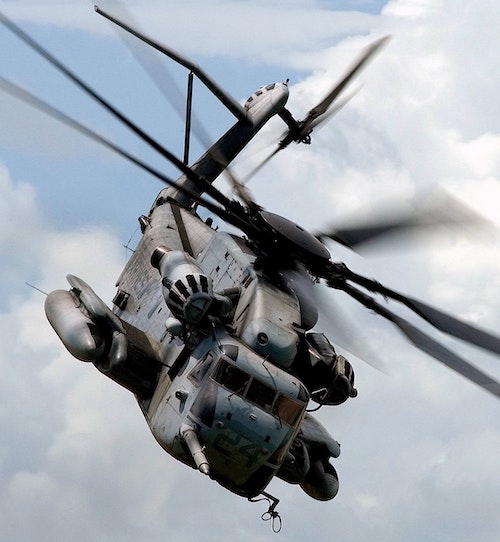Sikorsky CH-53 Sea Stallion
Summary
| Category | Helicopter |
| Origin country | 🇺🇸 United States |
| First flight | 14 October 1964 |
| Year of introduction | 1966 |
| Number produced | 284 units |
| Average unit price | $40 million |
Description
The CH-53 Sea Stallion originated from a March 1962 United States Navy requirement, issued on behalf of the US Marine Corps (USMC), to replace the Sikorsky CH-37 Mojave. Sikorsky responded with a proposal for a scaled-up S-61R, incorporating twin General Electric T64 turboshaft engines and dynamic systems derived from the S-64/CH-54, which was selected in July 1962. A $9,965,635 contract was awarded to Sikorsky in September 1962 for two YCH-53A prototypes, a mockup, and a ground-test airframe. The first YCH-53A conducted its maiden flight on 14 October 1964. The USMC placed an initial production order for 16 helicopters in September 1964, and the type was publicly introduced as the CH-53A Sea Stallion on 19 November 1964. Initial deliveries to operational units commenced on 12 September 1966.
The Sikorsky CH-53 Sea Stallion is a heavy lift military transport helicopter accommodating a crew of four: pilot, copilot, crew chief, and aerial observer. It can carry up to 38 fully-equipped troops, 24 litters with medical attendants, an internal cargo load of 8,000 pounds, or an external load of 13,000 pounds via a single-point sling hook. Access to the main cabin is facilitated by a large passenger door on the right side of the fuselage, behind the cockpit, and a power-operated loading ramp at the rear for drive-on loading operations. The helicopter's mechanical flight controls are supported by three independent hydraulic systems and it can be equipped for all-weather operation. It features a fully-articulated six-bladed main rotor and a four-bladed tail rotor; the high-speed requirement of the USMC was a primary factor in shaping the dynamic design. The CH-53 also incorporates a Blade Inspection Method (BIM) for detecting cracks in its metal rotors.
The CH-53D is generally armed with twin .50 BMG (12.7 mm) M2/XM218 machine guns. Some can also carry a ramp-mounted .50 BMG GAU-21 machine gun. The German CH-53G variant can mount two 7.62×51mm MG3 machine guns in the side doors, intended for replacement by two .50 BMG M3M/GAU-21 machine guns in the doors and one on the ramp. The RH-53D variant has a cargo hook capable of carrying 25,000 lb (11,340 kg) of cargo.
The CH-53/HH-53 has been extensively utilized in operational theaters. Its initial deployment was during the Vietnam War, where it was employed for aircraft recovery and personnel evacuation. The CH-53D later joined the CH-53A during the latter part of the US presence in Vietnam, and both aircraft participated in the evacuation of personnel during Operation Frequent Wind. U.S. Air Force HH-53 Super Jolly Green Giants served as search-and-rescue helicopters in Southeast Asia from 1967 to 1975, and were involved in operations such as the insertion of the Operation Ivory Coast rescue team into the North Vietnamese prison camp at Son Tay in 1970. Marine-flown Navy Sea Stallions participated in Operation Eagle Claw, the 1980 hostage rescue mission in Iran, and Marine CH-53s were active in Grenada during Operation Urgent Fury. Subsequently, the CH-53 supported operations Iraqi Freedom and Enduring Freedom.
Main Variants:
-
YCH-53A: Initial prototypes equipped with two 2,850 shp (2,130 kW) T64-GE-3 engines, serving as the basis for subsequent development.
-
CH-53A: The initial production variant for the USMC, with 139 aircraft built, establishing the Sea Stallion's operational service.
-
RH-53A: CH-53As re-engined with two 3,925 shp (2,927 kW) T64-GE-413 engines and converted into Airborne Mine CounterMeasures (AMCM) variants for the United States Navy, with 15 conversions made.
-
CH-53D: An improved CH-53A featuring an enhanced transmission, a larger cabin accommodating up to 55 troops, and an automatic rotor blade folding system, manufactured for the United States Marine Corps with 126 units built.
-
RH-53D: The United States Navy's AMCM variant of the CH-53D, equipped with 0.50-inch caliber machine guns and air refueling capabilities, with 30 built for the USN and six exported to Iran before 1979; it boasts a cargo hook capable of carrying 25,000 lb (11,340 kg) of cargo.
Technical specifications
| Version: CH-53E Super Stallion | |
|---|---|
| Crew | 2 pilots + 1 mechanic |
| Operational range | 2075 km (1289 mi) |
| Maximum speed | 315 km/h (196 mph) |
| Wingspan | 24.1 m (79.0 ft) |
| Height | 8.5 m (27.8 ft) |
| Length | 30.2 m (99.1 ft) |
| Service ceiling | 5639 m (18501 ft) |
| Empty weight | 15071 kg (33226 lbs) |
| Max. takeoff weight | 33300 kg (73414 lbs) |
| Climb rate | 13.0 m/s (42.7 ft/s) |
| Powerplant | 3 × turbines General Electric T64-GE-416 delivering 3270 kW |
Current operating countries
| Country | Units | ||
|---|---|---|---|
|
|
United States | 175 (+197) | |
|
|
Germany | 81 | |
|
|
Israel | 22 (+18) | |
|
|
Iran | 6 | |
Numbers in parentheses, e.g. '(+5)', indicate units ordered but not yet delivered.
Photo of CH-53 Sea Stallion

3-view profile
